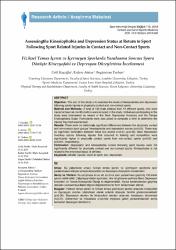| dc.contributor.author | Kaçoğlu, Celil | |
| dc.contributor.author | Atalay, Erdem | |
| dc.contributor.author | Turhan, Begümhan | |
| dc.date.accessioned | 2019-10-22T20:07:49Z | |
| dc.date.available | 2019-10-22T20:07:49Z | |
| dc.date.issued | 2018 | |
| dc.identifier.issn | 1300-0551 | |
| dc.identifier.uri | http://www.trdizin.gov.tr/publication/paper/detail/TWpreU56TXpNdz09 | |
| dc.identifier.uri | https://hdl.handle.net/11421/22426 | |
| dc.description.abstract | Objective: The aim of this study is to examine the levels of kinesophobia and depression following sports injuries in physically contact and non-contact sports. Material and Methods: A total of 130 male athletes from 14 different sports, who were injured at least six months before were included in the study. Individuals participating in the study were interviewed by means of the Beck Depression Inventory and the Tampa Kinesiophobia Scale. Participants were also asked to complete a form to determine the injuries they had experienced. Results: There were no statistically significant differences between the physically contact and non-contact sport groups’ kinesiophobia and depression scores (p>0.05). There was no significant correlation between these two scores (r=0.27, p>0.05). Beck Depression Inventory scores following injuries that occurred in training and competition were significantly higher in physically contact sports than non-contact sports (p<0.05 and p<0.001, respectively). Conclusion: Depression and kinesophobia scores following sport injuries were not significantly different for physically contact and non-contact sports. Kinesophobia is not related to the emotional status of athletes. | en_US |
| dc.description.abstract | Amaç: Bu çalışmanın amacı fiziksel temas içeren ve içermeyen sporlarda spor yaralanmasını izleyen süreçte kinezyofobi ve depresyon düzeylerini incelemektir. Gereç ve Yöntem: Bu çalışmaya en az altı ay önce spor yaralanması geçirmiş 130 erkek sporcu dâhil edildi. Çalışmaya katılan sporcular, bire bir görüşme şeklinde Beck Depresyon Envanteri ve Tampa Kinezyofobi Ölçeği ile değerlendirildi. Ayrıca katılımcılardan geçirmiş oldukları yaralanmaya ilişkin bilgileri değerlendiren bir form doldurmaları istendi. Bulgular: Fiziksel temas içeren ve fiziksel temas içermeyen sporlar arasında kinezyofobi ve depresyon skorları istatistiksel olarak anlamlı düzeyde farklılık göstermemektedir (p>0.05). Depresyon skorları ile kinezyofobi skorları arasında korelasyon bulunmadı (r=0.27). Antrenman ve müsabaka sırasında meydana gelen yaralanmalardan sonra belirlenen depresyon skorlarının fiziksel temas içeren sporlarda, fiziksel temas içermeyen sporlara göre anlamlı oranda yüksek olduğu bulundu (sırasıyla p<0.05 ve p<0.001). Sonuçlar: Spor yaralanmaları sonrası depresyon ve kinezyofobi skorlarının fiziksel temas içeren ve içermeyen sporlar arasında farklı olmadığı belirlendi. Kinezyofobinin sporcuların duygusal durumlarıyla ilişkili olmadığı söylenebilir. | en_US |
| dc.language.iso | eng | en_US |
| dc.rights | info:eu-repo/semantics/openAccess | en_US |
| dc.subject | Spor Bilimleri | en_US |
| dc.subject | Eğitim | en_US |
| dc.subject | Eğitim Araştırmaları | en_US |
| dc.title | Assessingthe Kinesiophobia and Depression Status at Return to Sport Following Sport Related Injuries in Contact and Non-Contact Sports | en_US |
| dc.title.alternative | Fiziksel Temas İçeren ve İçermeyen Sporlarda Yaralanma Sonrası Spora Dönüşte Kinezyofobi ve Depresyon Düzeylerinin İncelenmesi | en_US |
| dc.type | article | en_US |
| dc.relation.journal | Spor Hekimliği Dergisi | en_US |
| dc.contributor.department | Anadolu Üniversitesi, Spor Bilimleri Fakültesi, Antrenörlük Eğitimi Bölümü | en_US |
| dc.identifier.volume | 53 | en_US |
| dc.identifier.issue | 2 | en_US |
| dc.identifier.startpage | 67 | en_US |
| dc.identifier.endpage | 75 | en_US |
| dc.relation.publicationcategory | Makale - Ulusal Hakemli Dergi - Kurum Öğretim Elemanı | en_US] |


















